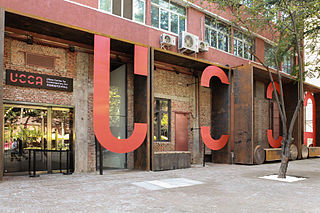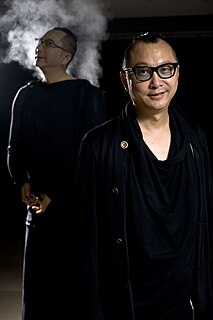
The Guggenheim Museum Bilbao is a museum of modern and contemporary art designed by Canadian-American architect Frank Gehry, and located in Bilbao, Basque Country, Spain. The museum was inaugurated on 18 October 1997 by King Juan Carlos I of Spain. Built alongside the Nervion River, which runs through the city of Bilbao to the Cantabrian Sea, it is one of several museums belonging to the Solomon R. Guggenheim Foundation and features permanent and visiting exhibits of works by Spanish and international artists. It is one of the largest museums in Spain.

The Solomon R. Guggenheim Museum, often referred to as The Guggenheim, is an art museum located at 1071 Fifth Avenue on the corner of East 89th Street in the Upper East Side neighborhood of Manhattan, New York City. It is the permanent home of a continuously expanding collection of Impressionist, Post-Impressionist, early Modern and contemporary art and also features special exhibitions throughout the year. The museum was established by the Solomon R. Guggenheim Foundation in 1939 as the Museum of Non-Objective Painting, under the guidance of its first director, the artist Hilla von Rebay. It adopted its current name after the death of its founder, Solomon R. Guggenheim, in 1952.

The Solomon R. Guggenheim Foundation is a nonprofit organization founded in 1937 by philanthropist Solomon R. Guggenheim and his long-time art advisor, artist Hilla von Rebay. The foundation is a leading institution for the collection, preservation, and research of modern and contemporary art and operates several museums around the world. The first museum established by the foundation was The Museum of Non-Objective Painting, in New York City. This became The Solomon R. Guggenheim Museum in 1952, and the foundation moved the collection into its first permanent museum building, in New York City, in 1959. The foundation next opened the Peggy Guggenheim Collection in Venice, Italy, in 1980. Its international network of museums expanded in 1997 to include the Guggenheim Museum Bilbao in Bilbao, Spain, and it expects to open a new museum, Guggenheim Abu Dhabi, in the United Arab Emirates in 2017.

Solomon Robert Guggenheim was an American businessman and art collector. He is best known for establishing the Solomon R. Guggenheim Foundation and the Solomon R. Guggenheim Museum in New York City.
Zhang Xiaogang is a contemporary Chinese symbolist and surrealist painter. Paintings in his Bloodline series are predominantly monochromatic, stylized portraits of Chinese people, usually with large, dark-pupiled eyes, posed in a stiff manner deliberately reminiscent of family portraits from the 1950s and 1960s. Recently, he also created sculptures, translating for the first time into three dimensions many characters of the sort seen in his "Bloodlines—Big Family" portrait series. These sculptures have featured in many exhibits and continue his work as one of China's leading, and most highly sought-after, contemporary artists.
Peter Young is an American painter. He is primarily known for his abstract paintings that have been widely exhibited in the United States and in Europe since the 1960s. His work is associated with Minimal Art, Post-minimalism, and Lyrical Abstraction. Young has participated in more than a hundred group exhibitions and he has had more than forty solo exhibitions in important contemporary art galleries throughout his career. He currently lives in Bisbee, Arizona.
Tang Muli is a Chinese painter and poet currently residing in Montreal, Quebec. He is the eldest son of celebrated Chinese film director Tang Xiaodan and brother of conductor Tang Muhai.
Liu Ye is a Beijing-based contemporary Chinese painter known for his bright-hued paintings of childlike female figures, his favorite cartoon character Miffy the bunny and works inspired by Piet Mondrian. Liu Ye is part of a generation of artists who grew up during the Cultural Revolution. However, unlike most acclaimed Chinese contemporary art, his works have little political implications. Instead, he prefers to use a universal language to depict his inner world. His work has been exhibited extensively in China, Europe and the United States.
Philip Tinari is a notable writer, critic, art curator, and expert in Contemporary Chinese Art. He is the director of the Ullens Center for Contemporary Art (UCCA) in Beijing.

Richard Armstrong is an American museum director. Since 2008, Armstrong has been the director of the Solomon R. Guggenheim Foundation, including the Solomon R. Guggenheim Museum in New York City and its other museums throughout the world. Before joining the Guggenheim, he was a curator at, and then director of, Carnegie Museum of Art in Pittsburgh, Pennsylvania. From 1981 to 1992, he had been a curator at the Whitney Museum of American Art.

Ullens Center for Contemporary Art or UCCA is a leading Chinese independent institution of contemporary art. Founded in 2007 out of a commitment to bring Chinese contemporary art into global dialogue, it has since become a cultural landmark for Beijing, a conduit for international exchange, and an incubator for new talent. Located at the heart of the 798 Art Zone in, China, it welcomes more than one million visitors a year. Originally known as the Ullens Center for Contemporary Art, UCCA underwent a major restructuring in 2017 and now operates as the UCCA Group, comprising two distinct entities: UCCA Foundation, a registered non-profit that organizes exhibitions and research, stages public programs, and undertakes community outreach; and UCCA Enterprises, a family of art-driven retail and educational ventures. UCCA's work grows from its core belief that new art can change lives, broaden perspectives, and enrich the conversation between China and the world.

Daniel J. Robbins was an American art historian, art critic, and curator, who specialized in avant-garde 20th-century art and helped encourage the study of it. Robbins' area of scholarship was on the theoretical and philosophical origins of Cubism. His writings centered on the importance of artists such as Albert Gleizes, Jean Metzinger, Henri Le Fauconnier and Jacques Villon. He was a specialist in early Modernism, writing on Salon Cubists and championed contemporaries such as Louise Bourgeois and the Color Field painters. Art historian Peter Brooke referred to Robbins as "the great pioneer of the broader history of Cubism".

Yuan Gong, is a Chinese contemporary artist. He has obtained a PhD degree in theory of art at the Chinese National Academy of Arts in 2012, but has immersed himself in different aspects of Chinese contemporary art since the 1990s. Being both creator and researcher, designer and planner, Yuan is a multiple facets artist playing at the interface of conceptual art, performance and fine arts. Using a large variety of media, his artworks address many philosophical questions, reflecting his concerns about the Chinese society and impugning the art system, the exhibition format and the status of the artwork.
Chen Danqing is a Chinese-American artist, writer, and art critic. He was well known for his realist paintings of Tibetans. Chen graduated from China Central Academy of Fine Arts. Because his grandfather moved to Taiwan with the Nationalist government, he also had citizenship in the Republic of China. He moved to the United States in the 1982 and became a citizen there.
Alexandra Munroe is a curator and historian of modern and contemporary art from Asia as well as a scholar of world art studies and transnational art history.
Woman Ironing (1904) is an oil painting by Pablo Picasso completed during the artist's Blue Period (1901—1904). This evocative image, painted in neutral tones of blue and gray, depicts an emaciated woman with hollowed eyes, sunken cheeks, and bent form, as she presses down on an iron with all her will. A recurrent subject matter for Picasso during this time is the desolation of social outsiders. This painting, as the rest of his works of the Blue Period, is inspired by his life in Spain but was painted in Paris.

Wang Jianwei is a new media, performance, and installation artist based in Beijing, China.
The Yangjiang Group is a collective artist group founded in 2002 by Zheng Guogu (b.1970), Chen Zaiyan (b.1971), and Sun Qinglin (b.1974). The group's name takes after their hometown in Yangjiang, Guangdong Province. The Yangjiang Group's works have been exhibited in Europe and Asia. Their works have been commented to show a strong attachment to a sense of place in their hometown.











